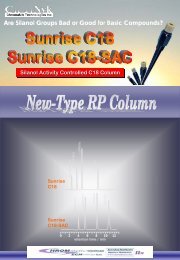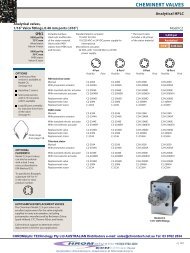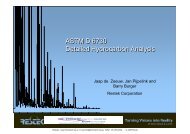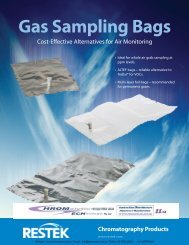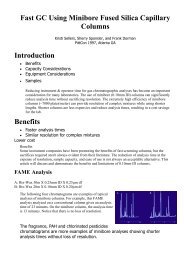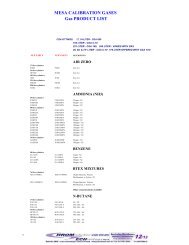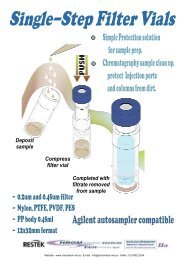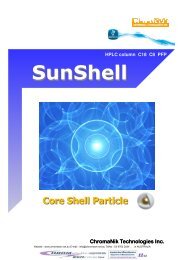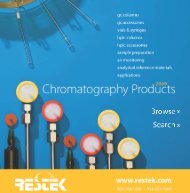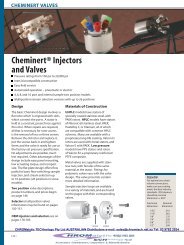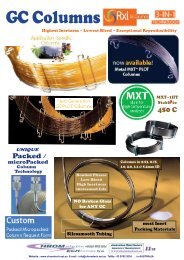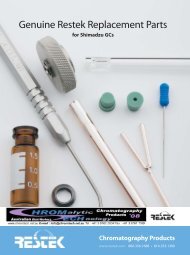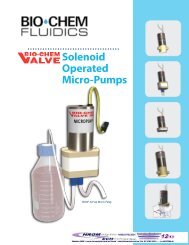gc columns
gc columns
gc columns
- No tags were found...
You also want an ePaper? Increase the reach of your titles
YUMPU automatically turns print PDFs into web optimized ePapers that Google loves.
GC COLUMNS | APPLICATION-SPECIFIC COLUMNSPetroleum & PetrochemicalChromaBLOGraphyTopical and timely insights from topchromatographers.Visit us at blog.restek.comRt®-Alumina BOND <strong>columns</strong> showunique retention characteristics forhydrocarbons.also availableMetal MXT® ColumnsRugged, flexible, Siltek® treated stainless steeltubing; inertness comparable to fused silicatubing. See page 108 for our MXT®-AluminaBOND/Na2SO4 <strong>columns</strong>.similar phasesGC-Alumina KCl, CP-Al2O3/KClLight Hydrocarbon AnalysisRt®-Alumina BOND Columns1. Highly selective for C1-C5 hydrocarbons; separates all unsaturated hydrocarbonisomers above ambient temperatures.2. Reactivity of aluminum oxide stationary phase is minimized so that columnresponse for polar unsaturates, such as dienes, is optimized. Column sensitivityor response ensures a linear and quantitative chromatographic analysis for thesecompounds.3. Strong bonding prevents particle generation. The column can be used in valveswitching operations, without release of particles that can harm the injection anddetection systems.4. The Rt®-Alumina BOND column is stable up to 200 °C. If water is adsorbed onthe column, it can be regenerated by conditioning at 200 °C. Full efficiency andselectivity will be restored.5. High capacity and loadability give exceptionally symmetric peaks; ideal for volatilehydrocarbon separations at percent levels, as well as impurity analyses at ppmconcentrations.Rt®-Alumina BOND/Na2SO4 Columns (fused silica PLOT)(Na2SO4 deactivation)ID df temp. limits 30-Meter 50-Meter0.25mm 4µm to 200°C 197750.32mm 5µm to 200°C 19757 197580.53mm 10µm to 200°C 19755 19756Refinery gas hydrocarbons on an Rt®-Alumina BOND/Na2SO4 column.Rt®-Alumina BOND/KCl Columns (fused silica PLOT)(KCl deactivation)• Acetylene elutes before C4 hydrocarbons (impurities in butane/isobutane).• Methyl acetylene (impurity in 1,3-butadiene) elutes before 1,3-butadiene.ID df temp. limits 30-Meter 50-Meter0.25mm 4µm to 200°C 197760.32mm 5µm to 200°C 19761 197620.53mm 10µm to 200°C 19759 19760Peak List1. methane2. ethane3. ethylene4. propane5. propylene6. isobutane7. n-butane8. propadiene9. acetylene10. trans-2-butene11. 1-butene12. isobutylene13. cis-2-butene14. isopentane15. n-pentane16. 1,3-butadiene17. trans-2-pentene18. 2-methyl-2-butene19. 1-pentene20. cis-2-pentene21. n-hexaneColumn: Rt ® -Alumina BOND/Na2SO4, 30m, 0.53mm ID, 10.0µm (cat.# 19755)Sample: refinery gas hydrocarbons through C6Inj.:10µL split, 40mL/min. split vent flow rate2mm split Precision ® liner w/wool (cat.# 20823)Inj. temp.: 200°CCarrier gas: helium, constant pressure (5.0psi, 34.5kPa)Linear velocity: 37.3cm/sec. @ 60°COven temp.: 60°C (hold 2 min.) to 200°C @ 10°C/min. (hold 1 min.)Det.: FID @ 200°CInstrument: Agilent 5890GC_PC0113976 www.restek.comWebsite : www.chromtech.net.au E-mail : info@chromtech.net.au TelNo : 03 9762 2034 . . . in AUSTRALIA Mar 2011



